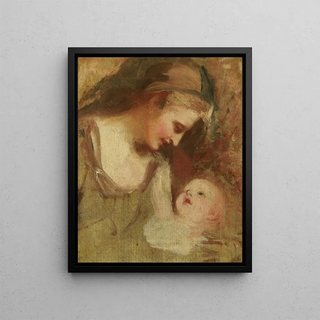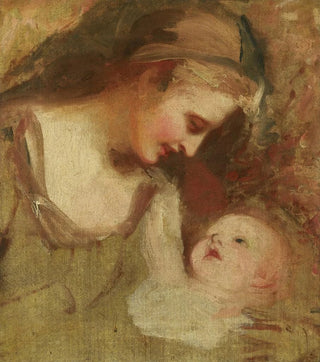Art print | Sketch of a mother and her child - George Romney


View from behind

Frame (optional)
In the fascinating world of art, some works manage to capture moments of unparalleled tenderness, transcending eras and styles. "Croquis d'une mère et de son enfant" by George Romney is one of these iconic pieces, where the simplicity of the subject blends with the depth of emotions. This sketch, with its delicate appearance, evokes a palpable intimacy between the mother and her child, a sacred bond that resonates with every observer. Through a light stroke and harmonious composition, Romney invites us to contemplate the beauty of this relationship, while immersing us in the universe of the 18th century where art was both a mirror of society and an expression of human feelings.
Style and uniqueness of the work
George Romney's style is distinguished by its ability to combine finesse and expressiveness. In "Croquis d'une mère et de son enfant," the artist uses flowing lines and delicate shadows to create a soft and soothing atmosphere. Every curve, every detail is carefully thought out to pay homage to motherhood. The posture of the mother, slightly leaning towards her child, evokes instinctive protection, while the tender gaze she directs at him touches us deeply. The color palette, although limited, plays a crucial role in creating this intimate ambiance. Warm nuances and subtle contrasts enhance the emotion conveyed by this work, making each observation a unique sensory experience. This sketch, far from being a simple outline, is a true ode to motherhood, revealing Romney's mastery in portrait art.
The artist and his influence
George Romney, a prominent figure in 18th-century British art, established himself through his talent and originality. Born in 1734, he was initially influenced by portrait masters but quickly developed a style that was uniquely his own. His ability to capture the essence of his subjects, both physically and emotionally, made him one of the most sought-after artists of his time. Romney was also a pioneer in exploring the representation of motherhood, a theme that, although present in

Matte finish

View from behind

Frame (optional)
In the fascinating world of art, some works manage to capture moments of unparalleled tenderness, transcending eras and styles. "Croquis d'une mère et de son enfant" by George Romney is one of these iconic pieces, where the simplicity of the subject blends with the depth of emotions. This sketch, with its delicate appearance, evokes a palpable intimacy between the mother and her child, a sacred bond that resonates with every observer. Through a light stroke and harmonious composition, Romney invites us to contemplate the beauty of this relationship, while immersing us in the universe of the 18th century where art was both a mirror of society and an expression of human feelings.
Style and uniqueness of the work
George Romney's style is distinguished by its ability to combine finesse and expressiveness. In "Croquis d'une mère et de son enfant," the artist uses flowing lines and delicate shadows to create a soft and soothing atmosphere. Every curve, every detail is carefully thought out to pay homage to motherhood. The posture of the mother, slightly leaning towards her child, evokes instinctive protection, while the tender gaze she directs at him touches us deeply. The color palette, although limited, plays a crucial role in creating this intimate ambiance. Warm nuances and subtle contrasts enhance the emotion conveyed by this work, making each observation a unique sensory experience. This sketch, far from being a simple outline, is a true ode to motherhood, revealing Romney's mastery in portrait art.
The artist and his influence
George Romney, a prominent figure in 18th-century British art, established himself through his talent and originality. Born in 1734, he was initially influenced by portrait masters but quickly developed a style that was uniquely his own. His ability to capture the essence of his subjects, both physically and emotionally, made him one of the most sought-after artists of his time. Romney was also a pioneer in exploring the representation of motherhood, a theme that, although present in






